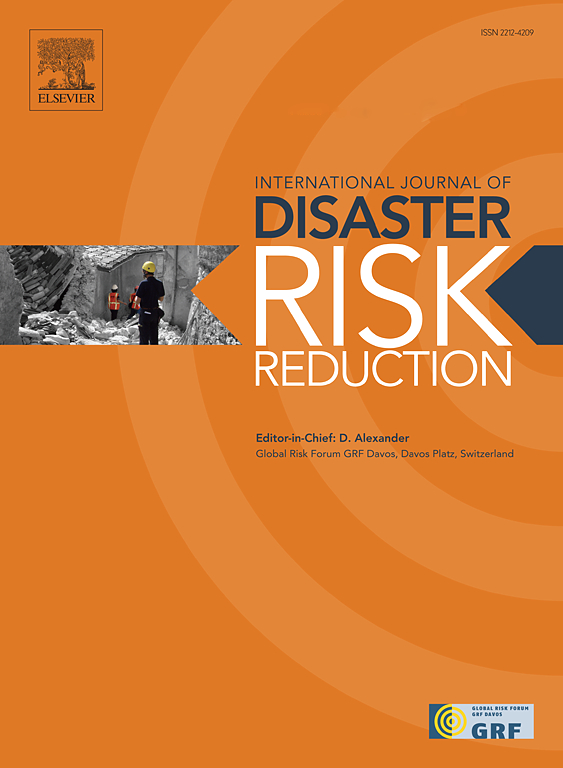干旱的社会脆弱性:印度西孟加拉邦普鲁利亚地区的时空评估
IF 4.2
1区 地球科学
Q1 GEOSCIENCES, MULTIDISCIPLINARY
International journal of disaster risk reduction
Pub Date : 2024-09-26
DOI:10.1016/j.ijdrr.2024.104846
引用次数: 0
摘要
气候变化、干旱和社会经济发展之间的相互作用极大地改变了全球社会经济体系中的干旱危害、脆弱性和风险。然而,在全球变暖的影响下,这些变化将如何在日益全球化的经济中体现在地方层面却缺乏了解。为了弥补这一知识空白,本研究采用了各种气候、人口和社会经济数据来绘制和评估印度西孟加拉邦普鲁利亚地区对干旱的社会脆弱性。采用归纳法,利用 11 项社会经济指标构建了社会脆弱性指数。降雨异常和标准化降水指数被用来评估干旱状况,而作物产量数据则有助于从空间上构建作物歉收指数。研究结果表明,自 2000 年以来,该地区的干旱频率和强度都在增加,导致农作物大幅减产和歉收。社会脆弱性指数结果表明,在 20 个易受干旱影响的分区中,有 14 个也处于社会经济边缘。灌溉不足、文盲、严重依赖农业、大量非工人以及资源获取渠道有限等因素导致了普鲁利亚分区在干旱面前的高度社会脆弱性。这项研究有助于决策者为这些弱势群体制定有针对性的适应和缓解战略。本文章由计算机程序翻译,如有差异,请以英文原文为准。
Social vulnerability to drought: A spatiotemporal assessment in purulia district, West Bengal, India
The interplay between climate change, drought, and socioeconomic development has significantly altered the hazards, vulnerability, and risk of drought within the global socioeconomic system. Yet, there is a lack of understanding of how these changes will manifest at the local level in an increasingly globalized economy under the effects of global warming. To bridge this knowledge gap, this study employs a variety of climatic, demographic, and socioeconomic data to map and assess the social vulnerability to drought in the Purulia district of West Bengal, India. Eleven socioeconomic indicators were utilized to construct a social vulnerability index using an inductive approach. Rainfall anomalies and standardized precipitation indices were employed to evaluate drought conditions, while crop yield data helped to spatially construct a crop failure index. The study reveals that the frequency and intensity of drought have increased in the district since 2000, leading to significant reductions in crop yield and failures. The social vulnerability index results indicate that 14 out of twenty drought-prone sub-districts are also socioeconomically marginalized. Factors such as inadequate irrigation, illiteracy, heavy reliance on agriculture, a high number of non-workers, and limited access to resources contribute to the high social vulnerability to drought in the Purulia sub-districts. This study can assist decision-makers in developing targeted adaptation and mitigation strategies for these vulnerable populations.
求助全文
通过发布文献求助,成功后即可免费获取论文全文。
去求助
来源期刊

International journal of disaster risk reduction
GEOSCIENCES, MULTIDISCIPLINARYMETEOROLOGY-METEOROLOGY & ATMOSPHERIC SCIENCES
CiteScore
8.70
自引率
18.00%
发文量
688
审稿时长
79 days
期刊介绍:
The International Journal of Disaster Risk Reduction (IJDRR) is the journal for researchers, policymakers and practitioners across diverse disciplines: earth sciences and their implications; environmental sciences; engineering; urban studies; geography; and the social sciences. IJDRR publishes fundamental and applied research, critical reviews, policy papers and case studies with a particular focus on multi-disciplinary research that aims to reduce the impact of natural, technological, social and intentional disasters. IJDRR stimulates exchange of ideas and knowledge transfer on disaster research, mitigation, adaptation, prevention and risk reduction at all geographical scales: local, national and international.
Key topics:-
-multifaceted disaster and cascading disasters
-the development of disaster risk reduction strategies and techniques
-discussion and development of effective warning and educational systems for risk management at all levels
-disasters associated with climate change
-vulnerability analysis and vulnerability trends
-emerging risks
-resilience against disasters.
The journal particularly encourages papers that approach risk from a multi-disciplinary perspective.
 求助内容:
求助内容: 应助结果提醒方式:
应助结果提醒方式:


